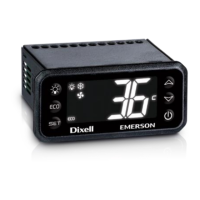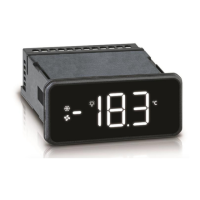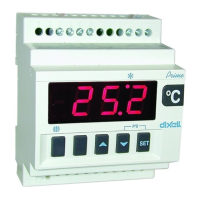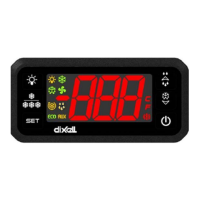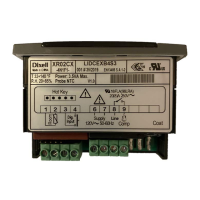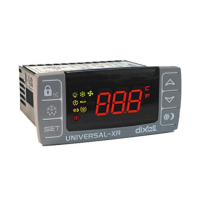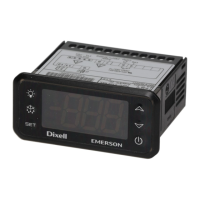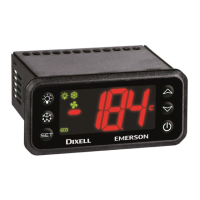1592020670 XRi77CX-CH GB r1.1 15.10.2019 XRi77CX-CH 5/9
Minimum temperature alarm:
If ALC=Ab: [-100°C to ALU; -148 to ALU];
If ALC=rE: [0.0 to 50.0°C or 0 to 90°F] when this temperature is reached the alarm is
enabled, after the Ald delay time.
Differential for temperature alarm recovery: (0.1 to 25.5°C; 1 to 45°F) intervention
differential for recovery of temperature alarm.
Temperature alarm delay: (0 to 255 min) time interval between the detection of an
alarm condition and alarm signalling.
Temperature alarm delay after power-on: (0.0 to 24h00min, res. 10min) time interval
between the detection of the temperature alarm condition after instrument power on
and alarm signalling.
CONDENSER TEMPERATURE ALARM
Second temperature alarm probe selection: (nP; P1; P2; P3; P4)
nP = no probe; P1 = thermostat probe; P2 = evaporator probe; P3 = configurable probe;
P4 = Probe on Hot Key plug.
Second low temperature alarm (absolute value): (-100 to 150°C; -148 to 302°F)
when this temperature is reached the LA2 alarm is signalled, possibly after the Ad2
delay.
Second high temperature alarm (absolute value): (-100 to 150°C; -148 to 302°F)
when this temperature is reached the HA2 alarm is signalled, possibly after the Ad2
delay.
Differential for second temperature alarm recovery: 0.1 to 25.5°C; 1 to 45°F
Second temperature alarm delay: (0 to 255 min) time interval between the detection
of the condenser alarm condition and alarm signalling.
Second temperature alarm activation delay after power-on: 0.0 to 24h00min, res.
10min.
Compressor off due to second low temperature alarm: (n; Y) n = compressor keeps
on working; Y = compressor is switched off till the alarm is present, in any case
regulation restarts after AC time at minimum.
Compressor off due to second high temperature alarm: (n; Y) n = compressor
keeps on working; Y = compressor is switched off till the alarm is present, in any case
regulation restarts after AC time at minimum.
Differential for anti-freezing control: (0.0 to 25.5°C; 1 to 45°F) low level threshold to
stop regulation.
Relay oA1 configuration (7-8): (dEF; Fan; Alr; LiG; AUS; onF; db; CP2; dEF2; HES;
Het; inV, CMP, nu) dEF = defrost; Fan = do not select it; Alr = alarm; LiG = light; AUS
= Auxiliary relay; onF = always on with instrument on; db = neutral zone; CP2 = second
compressor output; dF2 = do not select it; HES = night blind; Het = heater output; inV
= inverter compressor; CMP = ONOFF compressor; nu=not used.
Relay oA2 configuration (4-5-6): (dEF; Fan; Alr; LiG; AUS; onF; db; CP2; dEF2; HES;
Het; inV, CMP, nu) dEF = defrost; Fan = do not select it; Alr = alarm; LiG = light; AUS
= Auxiliary relay; onF = always on with instrument on; db = neutral zone; CP2 = second
compressor output; dF2 = do not select it; HES = night blind; Het = heater output; inV
= inverter compressor; CMP = ONOFF compressor; nu=not used.
Relay oA3 configuration (8-9): (dEF; Fan; Alr; LiG; AUS; onF; db; CP2; dEF2; HES;
Het; inV, CMP, nu) dEF = defrost; Fan = do not select it; Alr = alarm; LiG = light; AUS
= Auxiliary relay; onF = always on with instrument on; db = neutral zone; CP2 = second
compressor output; dF2 = do not select it; HES = night blind; Het = heater output; inV
= inverter compressor; CMP = ONOFF compressor; nu=not used.
Relay oA4 configuration (10-11-12): (dEF; Fan; Alr; LiG; AUS; onF; db; CP2; dEF2;
HES; Het; inV, CMP, nu) dEF = defrost; Fan = do not select it; Alr = alarm; LiG = light;
AUS = Auxiliary relay; onF = always on with instrument on; db = neutral zone; CP2 =
second compressor output; dF2 = do not select it; HES = night blind; Het = heater
output; inV = inverter compressor; CMP = ONOFF compressor; nu=not used.
Analogue output configuration: (n;Y) n = 5-pin port is used for HOT-KEY; Y = 5-pin
port is used as frequency output.
Alarm relay polarity: (oP; CL) oP = the relay is activated by opening the contact; CL
= the relay is activated by closing the contact.
Digital input 1 polarity: (oP; CL) oP = the digital input is activated by opening the
contact; CL = the digital input is activated by closing the contact.
Digital input 1 configuration: (EAL; bAL; dor; dEF; ES; AUS; Htr; HdF; onF; nt) EAL
= external alarm: “EA” message is displayed; bAL = serious alarm “CA” message is
displayed; dor = door switch function; dEF = activation of a defrost cycle; ES = energy
saving; AUS = auxiliary relay activation with oAx=AUS; Htr = type of inverting action
(cooling or heating); HdF =do not set it; onF = to switch the controller off; nt = to change
parameter map
Digital input 2 input polarity: (oP; CL) oP = the digital input is activated by opening
the contact; CL = the digital input is activated by closing the contact.
Digital input 2 configuration: (EAL; bAL; dor; dEF; ES; AUS; Htr; HdF; onF; nt) EAL
= external alarm: “EA” message is displayed; bAL = serious alarm “CA” message is
displayed; dor = door switch function; dEF = activation of a defrost cycle; ES = energy
saving; AUS = auxiliary relay activation with oAx=AUS; Htr = type of inverting action
(cooling or heating); HdF =do not set it; onF = to switch the controller off; nt = to change
parameter map
Digital input 1 alarm delay: (0 to 255 min) delay between the detection of the external
alarm condition and its signalling.
When i1F= PAL, it is the interval of time to calculate the number of pressure switch
activation.
Digital input 2 alarm delay: (0 to 255 min) delay between the detection of the external
alarm condition and its signalling.
When i1F= PAL, it is the interval of time to calculate the number of pressure switch
activation.
Number of pressure alarm events before stopping the regulation (Lock alarm):
(1 to 15) after nPS activations of the ixF=BAL digital input the regulation will be stopped.
Compressor and fan status after door opening: (no; Fan; CPr; F_C) no = normal;
Fan = normal; CPr = compressor OFF, F_C = compressor OFF.
Regulation restart after open door alarm: (n; Y) n = outputs follow the odC
parameter. Y = outputs restart with a door open alarm.
Differential for energy saving mode: (-30.0 to 30.0°C; -54 to 54°F) it sets the
increasing value of the set point [SET+HES] during the Energy Saving cycle.
Energy saving mode controls the lights (lights off when energy saving goes
active): (n, Y) n= lights are independent from energy saving; Y = lights are turned OFF
when energy saving mode is activated
CURRENT TIME AND WEEKLY HOLIDAYS (ONLY FOR MODELS WITH RTC)
Day of the week: Sun to Sat
Day of the month: 1 to 31
First day of weekend: (Sun to Sat; nu) set the first day of the week which follows the
holiday times.
Second day of weekend: (Sun to Sat; nu) set the second day of the week which
follows the holiday times.
N.B. Hd1, Hd2 can be set also as “nu” value (Not Used).
ENERGY SAVING TIMES (ONLY FOR MODELS WITH RTC)
Working days Energy saving starting time: (0 to 23h50min) during the Energy
Saving cycle the set point is increased by the value in HES so that the operation set
point is SET+HES.
Working days Energy saving duration: (0 to 24h00min) sets the duration of the
Energy Saving cycle on workdays.
Holyday Energy saving starting time: 0 to 23h50min.
Holyday Energy saving duration: 0 to 24h00min.
DEFROST TIMES (ONLY FOR MODELS WITH RTC)
Daily defrost: (n; Y) to enable the Ld1…Ld6 defrost operations for all the days
of the week.
Defrost starting time: (0 to 23h50min) these parameters set the beginning of
the 6 programmable defrost cycles during workdays. Ex: when Ld2=12.4 the
second defrost starts every Monday at 12.40.
N.B.: To disable a defrost cycle set it to “nu”(not used). Ex: if Ld6=nu; the sixth defrost cycle will
be disabled.
OTHER
Serial address: (1 to 247) identifies the instrument address when connected to a
ModBUS compatible monitoring system.
ONOFF button configuration: (nu; oFF; ES) nu=not used; oFF=to switch OFF and
ON the controller; ES=to enable and disable enersy saving mode
ONOFF button timed (3sec) configuration: (nu; oFF; ES) nu=not used; oFF=to
switch OFF and ON the controller; ES=to enable and disable enersy saving mode
Light button timed (3sec) configuration (left upper side): (nu; LiG; AUS; Lnt)
nu=not used; LiG= to activate and deactivate light output; AUS=to activate and
deactivate the auxiliary output; Lnt=to change parameter map
Down button timed (3sec) configuration: (nu; Std; Lnt; Pnd) nu=not used;
Std=standard use; Lnt= to change parameter map; Pdn=to activate a Pull Down cycle.
Probe P1 value visualization: read only
Probe P2 value visualization: read only
Probe P3 value visualization: read only
Probe P4 value visualization: read only
Instantaneous Variable Speed Drive speed (in percentage): read only
Real set point: it shows the set point used during the energy saving cycle or during
the continuous cycle.
Firmware release for internal use.
Parameter table code: readable only.
14. DIGITAL INPUTS
The first digital input (terminals 18-20) is enabled with P3P=n.
With P3P=n and i1F=i2F the second digital input is disabled.
The free voltage digital inputs are programmable by the i1F and i2F parameters.
14.1 GENERIC ALARM (IXF = EAL)
As soon as the digital input is activated the unit will wait for did time delay before signalling the “EAL”
alarm message. The outputs status doesn’t change. The alarm stops just after the digital input is de-
activated.
14.2 SERIOUS ALARM MODE (IXF = BAL)
When the digital input is activated, the unit will wait for did delay before signalling the “CA” alarm
message. The relay outputs are switched OFF. The alarm will stop as soon as the digital input is de-
activated.
14.3 DOOR SWITCH INPUT (IXF = DOR)
It signals the door status and the corresponding relay output status through the odC parameter:
no = normal (any change); FAn = Fan OFF; CPr = Compressor OFF; F_C = Compressor and fan OFF.
Since the door is opened, after the delay time set through parameter doA, the door alarm is enabled,
the display shows the message dA and the regulation restarts is rtr=Y. The alarm stops as soon as
the external digital input is disabled again. With the door open, the high and low temperature alarms
are disabled.
14.4 START DEFROST (IXF = DEF)
It starts a defrost if there are the right conditions. After the defrost is finished, the normal regulation will
restart only if the digital input is disabled otherwise the instrument will wait until the MdF safety time is
expired.

